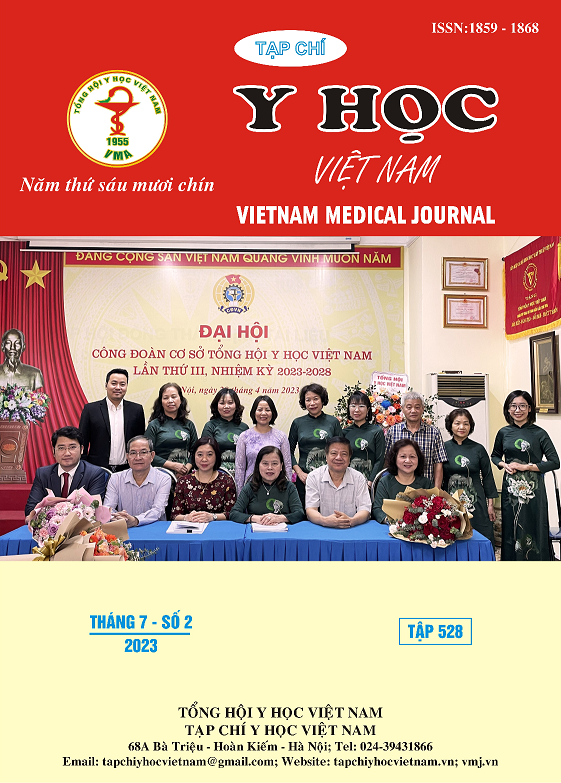INSOMNIA AND RELATED FACTORS IN UNIVERSITY STUDENTS IN HO CHI MINH CITY
Main Article Content
Abstract
Objectives: Insomnia is the most common sleep disorder and affects many aspects of physical health, mental health as well as academic performance in students. This study was conducted to estimate the prevalence and identify the associated factors with insomnia in university students at Ho Chi Minh city. Material and methods: a cross-sectional study was conducted in four universities in Ho Chi Minh city through an online survey. We used Google Forms to collect data about background information, smartphone behaviors, internet access habits, and Insomnia Severity Index (ISI) in which a cut-off score of ≥ 15 was decided to have clinical insomnia. Results: Among 2034 students involved in this study, the prevalence of clinical insomnia was 24,9%. We also found that insomnia was more frequent in students ≥ 21 years old (OR = 1,25 95% CI: 1,01-1,53), 3rd and 4th-year students (OR=1,36 95% CI: 1,08-2,69), average academic performance (OR = 1,76 95% CI: 1,33-2,31), poor academic performance (OR =2,08 95% CI: 1,05-4,10). In addition, there were strong associations between insomnia and academic stress (OR=2,12 95%CI: 1,51-2,95), exam stress (OR=2,17 95%CI: 1,74-2,71), using smartphone before bed (OR=1,93 95%CI: 1,06-3,51) and addicting to smartphone (OR=1,84 95%CI 1,48-2,28). Conclusion: Insomnia is a common disorder among university students. Students should promote healthy sleep as well as increased awareness of the negative impact their sleep habits have on academic performance, physical and mental health.
Article Details
Keywords
insomnia, university students
References
1. Nguyễn Thị Thanh Tuyền, Lê Minh Thuận, Hoàng Thị Tuấn Tình. Tỉ lệ mất ngủ và các yếu tố liên quan ở sinh viên y tế công cộng và y học dự phòng, đại học y dược thành phố Hồ Chí Minh năm 2016. Tạp chí Y Học TP. Hồ Chí Minh, 21 (1), 80 - 86, 2017.
2. M. Alqudah, Samar A. M. Balousha, O. Al-Shboul, A. Al-Dwairi, Mahmoud A. Alfaqih, Karem H. Alzoubi. Insomnia among Medical and Paramedical Students in Jordan: Impact on Academic Performance. BioMed research international, 2019, 7136906-7136906, 2019.
3. American Psychiatric Association. Insomnia Disorder. Diagnostic and statistical manual of mental disorders: DSM-5. 363, 2013.
4. S. Carrión-Pantoja, G. Prados, F. Chouchou, M. Holguín, Á Mendoza-Vinces, M. Expósito-Ruiz, et al. Insomnia Symptoms, Sleep Hygiene, Mental Health, and Academic Performance in Spanish University Students: A Cross-Sectional Study. J Clin Med, 2022.
5. N. Choueiry, T. Salamoun, H. Jabbour, N. El Osta, A. Hajj, L. Rabbaa Khabbaz. Insomnia and Relationship with Anxiety in University Students: A Cross-Sectional Designed Study. PLoS One, 2016.
6. J. F. Gaultney. The Prevalence of Sleep Disorders in College Students: Impact on Academic Performance. Journal of American College Health, 59 (2), 91-97, 2010.
7. S. F. Hammoudi, H. W. Mreydem, B. T. A. Ali, N. O. Saleh, S. Chung, S. Hallit, et al. Smartphone Screen Time Among University Students in Lebanon and Its Association With Insomnia, Bedtime Procrastination, and Body Mass Index During the COVID-19 Pandemic: A Cross-Sectional Study. Psychiatry Investig, 18 (9), 871-878, 2021.
8. C. M. Morin, Geneviève Belleville, Lynda Bélanger, Hans Ivers. The Insomnia Severity Index: psychometric indicators to detect insomnia cases and evaluate treatment response. Sleep, 34 (5), 601-608, 2011.
9. X. L. Jiang, X. Y. Zheng, J. Yang, C. P. Ye, Y. Y. Chen, Z. G. Zhang, et al. A systematic review of studies on the prevalence of insomnia in university students. Public Health, 129 (12), 1579-84, 2015.
10. F. Younes, G. Halawi, H. Jabbour, N. El Osta, La. Karam, Al. Hajj, et al. Internet Addiction and Relationships with Insomnia, Anxiety, Depression, Stress and Self-Esteem in University Students: A Cross-Sectional Designed Study. PloS one, 2016.


